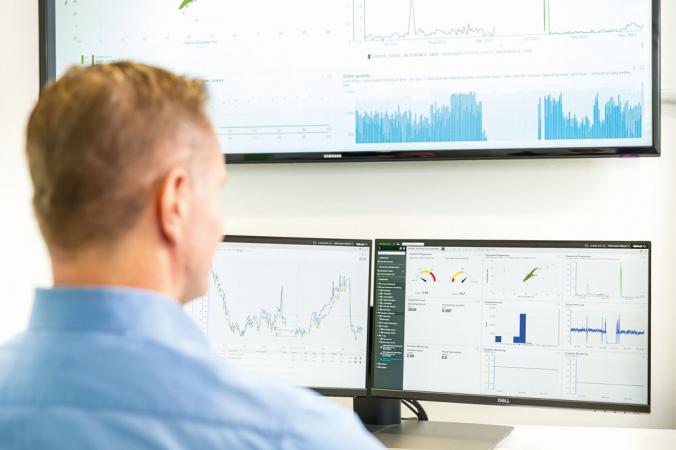Maintenance Management System: Implementation for Off-Shore Platforms
The Computerized Maintenance Management System (CMMS) is to be developed in order to provide a tool that helps maintenance departments control and manage all related to plant maintenance. It will help develop ”continuous improvement” on numerous complex areas of maintenance on North Adriatic production platforms.
One possible definition of maintenance is roughly the following: ”When a certain plant, or factory starts its operations, all further activities are – maintenance”. As a person with a long history in maintenance, I am convinced that this short, and some may say biased definition, is completely correct as it gives importance to people engaged in maintenance.
During my career I had opportunity to participate in implementation of SAP maintenance management system – maintenance module in INA and now in implementation of CMMS for the exactly the same purpose. This has encouraged me and the co-author of this paper to provide all others engaged in maintenance with our experience of CMMS implementation. First we need to introduce ourselves, our company.
INAgip is an operating company with over 17 gas production platforms in the North Adriatic offshore (16 production and one compressor platform) which were constructed between 1997 and 2010. 41 wells have been drilled (35 of which are still currently working), and there are 75 production strings equipped with separators and complete managing equipment (”chokes”, level transmitters, pressure and limit switches, valves – manual or regulating – LV, SDV, ball and safety valves). The following data shows how complicated these systems and equipment really are; there are several systems for power generation
• Gas and diesel aggregates
• Ormat – generators
• Thermo-electrical generators
• Micro-turbines
• Photovoltaic panels
For gas transportation to onshore, 4 turbines with 8 compressors were installed on the Ivana K platform. There are also other pieces of specialist equipment including water and oil exchangers, submersible pumps, dehydration columns with accompanying regulatory devices, TEG regeneration units and management and surveillance systems.
As time goes by, platforms and their equipment are getting older. The strategy over the last three years has been that regular maintenance be performed by workers on the platform with other specific jobs carried out by contractors based on contracts or, where possible, by our employees. However, heavy work (major services, general repairs) on turbo compressors, pumps and HVAC system generators are performed by specialized and authorized companies.
There are different manufacturers present on platforms. Our target in future is to have equipment only from established manufacturers with the required quality standards. Certain pieces of equipment are not the most up to date, which makes the procurement of spare parts very difficult. I am stating all this to give you a better picture of a very demanding job with special working conditions, which our only recently established maintenance department is facing.
I hope that the listed information gives you an insight into various pieces of equipment that must meet special conditions. From the maintenance point of view, the following can be noted:
• Various pieces of equipment are constantly under very demanding conditions, humidity, temperatures, wind and extreme weather conditions, which man faces only several days at a time on a platform
• Under negative conditions aging occurs faster
• Possible interventions or regular maintenance operations are sometimes not possible due to bad weather
• Highly trained, selected people are needed
• Transportation of people and equipment is not always possible
How maintenance was performed
In the past a repair/maintain principle, meaning work is only carried out when equipment stops functioning. Such a principle increases the risk to equipment and people on a daily basis.
We were using a system in maintenance, which required the issuing of requests for material, spare parts and work orders. The Maintenance Department processes over 400 urgent requests annually, which are issued by platform personnel requesting materials or spare parts according to which the Maintenance Department reviews and forwards over 300 ROMS (request of materials) to the Procurement Department. This was when the process of technical specification preparation, collecting of bids, technical and commercial evaluation, preparation of contracts and Management approval began. That was the reason why CMMS has been selected.
The system has been planning module developed, tested and installed many times in practice. The CMMS database needs only to be adjusted to special requirements and in accordance with Croatian authorities like Croatian Register of Shipping (HRB), Ex-Agency, and Mining Inspectorate.
Reasons for CMMS implementation
Introducing preventative maintenance through CMMS should enable the following:
• Systematic, preventive maintenance of installed equipment and installations on all 17 platforms.
• Planning and timely procurement of spare parts.
• Planned maintenance work on all equipment shall be performed through the issuing of work orders for personnel on platforms and for contractors on a daily, weekly and monthly basis. By issuing work orders, personnel shall have an exact working plan for each day.
• CMMS implementation shall reduce the cost of urgent procurement and interventions and unplanned delays shall be decreased to the lowest extent.
• The system shall track the state of supplies and shall react if the level of supplies has fallen below a minimum level.
The computerized maintenance management system, also known as Enterprise Asset Management (EAM), is a group of software programmes that improve productivity, which certain branches of the industry uses for better capital asset management. CMMS enables companies to monitor location, usage, maintenance conditions and operating expenses for certain machines within their process. It can also be used for recording, managing and awarding everyday tasks to workers engaged in maintenance, and for generating reports on maintenance operations.
Statistics are amazing – they show that the implementation of almost 50 percent of all computer maintenance management systems (CMMS) do not succeed. Expenses related to CMMS that show a success rate of 50 percent are uncomfortable for each company. However, with simple steps for a well-developed implementation plan, everyone can get the full potential that CMMS can bring to their organization. What follows is an introduction to the steps that you may take to ensure the successful implementation of CMMS.
There are four primary functions of Computer Maintenance Management System:
1. Assets management
2. Work orders management
3. Preventive maintenance planning
4. Inventory planning
Within our maintenance activities, the most important issue is following. CMMS work order management modules enable companies to monitor all aspects of equipment repairs, and to define the priorities within a work schedule. When a failure on a certain part of a piece of equipment occurs, the module system for a work order activates the system in which personnel working on maintenance report the problem, usually in the form of an e-mail. Certain systems allow only a simple text message while other programmes require detailed information like serial number of the equipment, location, description of a problem or failure code and information whether the equipment can be used at its current location.
Preventative maintenance is a procedure of implementing routine cleaning and service on equipment according to manufacturers’ instructions. These services are mostly based on calendar-based systems or usage-based systems. With calendar-based systems, services are performed on a daily, weekly, monthly or annual basis. Most equipment has its own specific items that need to be performed within each interval, sometimes even more.
Usage-based systems shall be structured around the reading of working-hours meter readings. When a certain number of rotations/hours is achieved, special maintenance activities are needed. Very often, usage-based systems also include services based on calendar. This basic planning is created for equipment maintenance in high-level production companies.
Amount of implementation
The total number of processed items in MEL is 23.753. Thus Ivana A & Ivana K platforms have a total of 7.010 items while Ivana D platform has 252 items; it all depends on the complexity of a platform.
During risk matrix evaluation, for each tag three basic values were used: HSE effect, production effect, cost of repair.
For high and mid risk equipment, there is a list of spare parts which includes the following information:
• Manufacturer
• Model
• Type related to spare parts list
• Model related to the type of installed equipment and tag number
• Manufacturer’s catalogue
• Spare part strategy – OND (on demand) or OSL (on stock level)
• Defined values of maximal, minimal and maximal order quantities, in case of OSL
• SPIL- Spare Part Interchangeability List
Planning of activities and composing work orders
Basic factors in planning include legally prescribed deadlines like safety valves inspection, transmitters calibration and similar. The Planner is in charge of selection and planning (e.g. assign resources in terms of material, spare parts, tools and manpower) and scheduling (assign a date of foreseen execution). Initial users interface is the first and most important contact with the system. After an activity has been selected, the planner’s task is to provide all the necessary resources (spare parts, tools and manpower) necessary for the planned activities according to previously predefined activities for preventive maintenance.
Work order has to contain information like:
• Equipment identification number
• Tag number
• Model and manufacturer
• Detailed description of activities
• List of necessary tools
• List of necessary spare parts
When a work order is processed, the printed version should include information that descrives possible difficulties during operation and conclusions to be used during the preparation of future activities like source of improvement of the maintenance management system itself. Upon completion of a work order, the planner enters into the system all information related to that work order like used material, human resources, active work hours, contractors cost, stand by time. After a work order is closed the system generates the next work order with time review according to the previously defined periodicals.
Considering the experience with SAP and this system we can point out that the advantages of SAP are the following:
• Using the Zero Based Budgeting method in costs planning for 2 – 3 years resulted in perfect system and precise and good quality planning.
• Reporting on costs, work orders, services and used materials and spare parts is definitely of high quality.
• Description of parts, material and coding is more systematic and better at INA SAP
• Integration with other functions within a company has been achieved.
Lessons learned during the process
As we have already mentioned, over 50 percent of such systems fail during implementation. We believe that we have already overcome such an obstacle. As of August 1st 2013 the system is complete and all platforms included in the system have maintenance performed through CMMS.
Recorded advantages:
• Higher focus on work itself, with work order and instructions for performing certain operations with a list of tools and spare parts.
• The role of the planner is important; the planner is the focal point of system.
• Implementation includes various mechanisms for efficient performance of tasks including the automatic recording of activities, reminders, alarms, escalation procedures and easy access to information.
• Personnel have more time to dedicate to providing service and less time spent on data processing and entering.
CMMS is a tool for high quality maintenance that results in safe and continuous production under specific complex conditions. We shall develop, change, and modify this tool in future to acquire most efficient maintenance system. The reports need to be made in high detail; work plans need to be related to maintenance experience and not only to recommendations or manufacturers’ instructions. This is a basis for integration with other functions like storage, procurement and finances.













